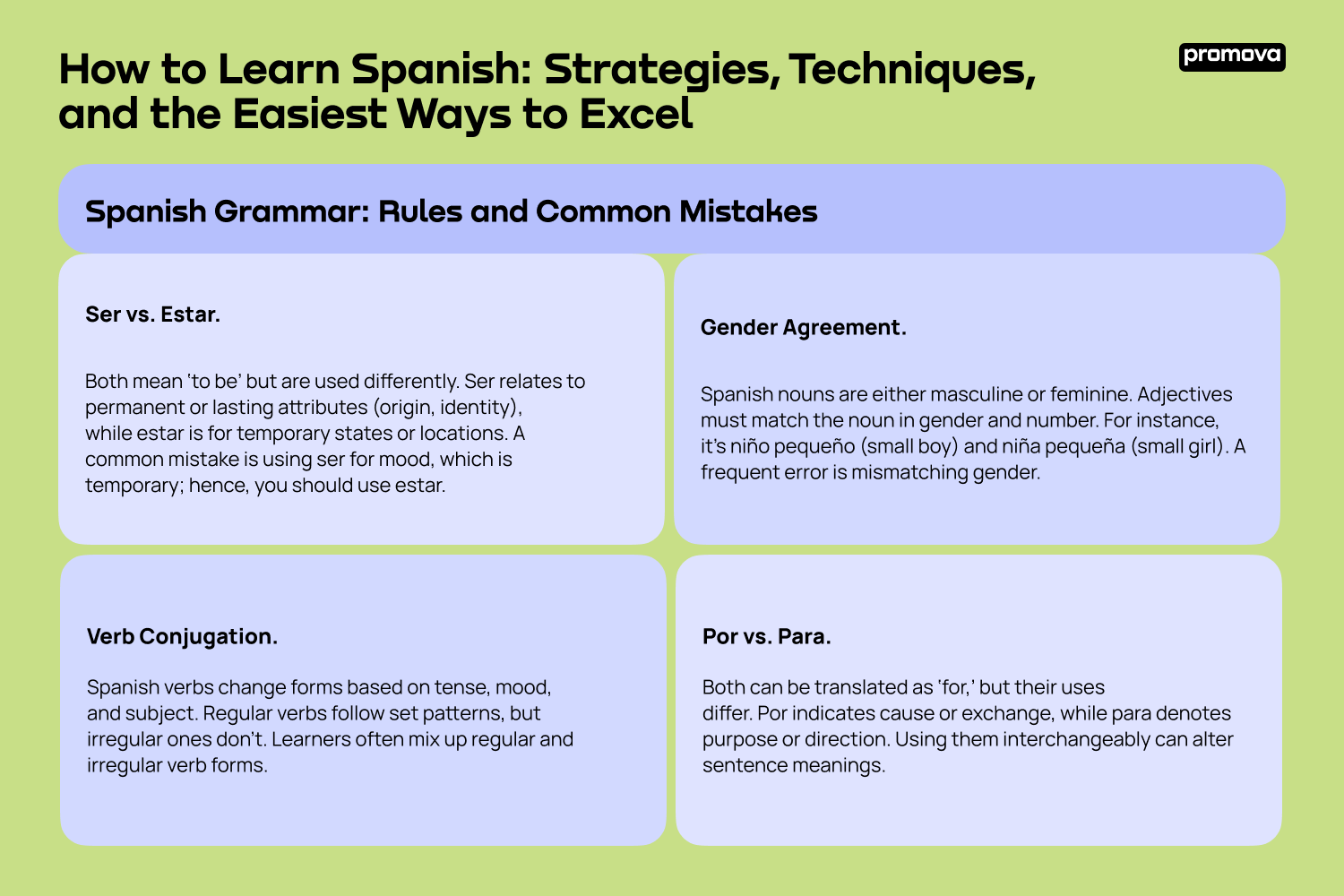How to Learn Spanish: Strategies, Techniques, and the Easiest Ways to Excel

Contents
Many people share the sentiment: I want to learn Spanish but often feel lost on where to begin. Spanish, spoken by over 460 million native speakers worldwide, is a key global language. Learning it can open doors to new cultures, travel experiences, and professional opportunities. If you’ve ever wanted to unlock this door, here’s a simple guide. This article details the basics of learning Spanish, highlights effective techniques to ease your journey, and provides real-world examples showcasing their implementation.
Reasons to Learn Spanish
Spanish is more than just a language; it’s a gateway to cultures, histories, and opportunities. Delving into the reasons to teach yourself Spanish can provide motivation and context for your linguistic journey:
- Global Communication. Spanish is the second most spoken language in the world by native speakers. Mastering it opens doors to communicating with people across 21 countries.
- Business Opportunities. The Spanish-speaking market is vast and varied. The language can be a significant asset in global business, from Spain’s technological industries to Latin America’s emerging economies.
- Cultural Enrichment. Spanish literature, cinema, and music are renowned worldwide. Learning the language offers a deeper understanding and appreciation of these cultural treasures.
- Travel Experiences. Spanish-speaking countries, from the historic streets of Barcelona to the scenic beauty of Patagonia, offer diverse travel experiences. Speaking the language enhances these adventures, allowing for more authentic interactions.
Learning Spanish is not just about acquiring a new skill but about embracing a global community. The benefits of grasping it are multifaceted, whether for professional growth, cultural exploration, or personal satisfaction.
Diving into the Roots: The Spanish Language Family
Spanish, often called Castilian, traces its origins back to the Iberian Peninsula, where many languages and dialects once flourished. It’s a member of the larger Indo-European language family, including English, French, and German.
Spanish evolved from a group of Vulgar Latin dialects spoken in the northern regions of Spain. Over time, as the Reconquista progressed and the Moors were driven out of Spain, these dialects consolidated, leading to what we recognize as Spanish today.
One of the significant influences was the Arabic language due to the 800 years of Moorish rule over the Iberian Peninsula. This influence is evident in the lexicon; it’s estimated that around 4,000 Spanish words are of Arabic origin, such as azul (blue) and naranja (orange).
Another layer of complexity is the existence of regional languages in Spain, such as Catalan, Galician, and Basque. These aren’t just dialects but are languages in their own right, with their histories and influences.
In the modern era, Spanish has spread far beyond the Iberian Peninsula, becoming the official or national language in 21 countries, largely due to Spain’s colonial history. This global spread has led to various dialects and nuances in different regions, from the Rioplatense Spanish of Argentina to the Caribbean Spanish of Puerto Rico.
The Power of Goal Setting in Language Learning
Starting the journey of language acquisition without clear objectives can be daunting. In this context, goal setting serves as a guiding light. It guarantees learners remain on track and motivated. Here’s why defining objectives is essential:
- Tangible Objectives. Instead of a vague desire, goals provide specificity. For example, ‘I aim to hold a 15-minute conversation in Spanish in three months’ offers clarity and a measurable target.
- Boosted Motivation. The path of language learning has its highs and lows. Clear goals act as motivational anchors, reminding learners of their ultimate aims during challenging times.
- Individualized Learning. Everyone’s linguistic journey is unique. Goals allow for tailored experiences. Whether mastering business Spanish or delving into literature, they ensure alignment with personal interests.
- Regular Assessment. With set objectives, learners can periodically gauge their progress. This regular check-in helps identify areas of improvement and, if necessary, adjust strategies.
- Structured Approach. Goals provide a roadmap with clear steps to learning Spanish. They break down the vast endeavor into manageable milestones, making the process more structured and less intimidating.
Setting clear objectives is beneficial and essential in Spanish mastery. It transforms the abstract desire to learn into a concrete plan of action. By defining and adhering to goals, learners can navigate the complexities of a new language with greater confidence and clarity.
What is the Best Way to Learn Spanish
Determining the best way to learn Spanish is subjective, depending on individual preferences, learning styles, and goals. However, based on educational research and the experiences of countless language learners, certain methods consistently prove to be effective. Here’s a breakdown:
- Immersive Learning. Immersion is often touted as the easiest way to learn Spanish. Surrounding oneself with the language, such as living in a Spanish-speaking country or engaging in language exchange programs, can accelerate fluency. Real-world interactions force learners to think and respond in Spanish, enhancing comprehension and speaking skills.
- Structured Courses. Enrolling in online courses provides a systematic approach. They often cover grammar, vocabulary, reading, writing, listening, and speaking, ensuring a well-rounded learning experience. For instance, guided courses by Promova are often praised for their interactive lessons and comprehensive structure.
- Private Tutors. One-on-one sessions with a tutor can address specific challenges and adapt to individual learning paces. Some benefits include immediate feedback, pronunciation corrections, and insights into cultural contexts.
- Interactive Tools and Apps. Digital platforms offer interactive lessons that adapt to the learner’s pace. They’re convenient, allowing learners to practice anytime, anywhere. You can try the Promova Spanish language learning app for this purpose and learn the language with its interactive features.
- Cultural Engagement. Delving into Spanish movies, music, literature, and podcasts can enhance understanding and appreciation. It’s entertaining to pick up colloquialisms, improve listening skills, and immerse oneself in the culture.
- Consistent Practice. Regardless of the chosen method, consistency is key. Daily practice, even if it’s just for a few minutes, reinforces learning and aids long-term retention.
The best way to learn Spanish combines various methods tailored to the person’s preferences and goals. A blend of structured learning, real-world practice, and cultural immersion yields the most fruitful results.
How to Learn Spanish on Your Own: Step-by-Step Instructions
The freedom to tailor your learning experience is empowering, but it also requires discipline and a strategic approach. Here is the comprehensive list of steps to learn Spanish:
- Define Clear Goals. Start by pinpointing what you hope to achieve. Do you want to converse fluently during travels, or are you more inclined towards reading Spanish literature? Setting specific objectives, such as ‘I want to order food,’ provides direction and motivation, ensuring you remain focused throughout your journey.
- Lay a Strong Foundation. Begin with the Spanish alphabet, basic pronunciation rules, and essential phrases. A solid foundation is paramount. For instance, understanding the nuances of the ‘r’ or knowing how to say ‘hi’ in Spanish can significantly impact your communication skills.
- Dive into Grammar. While grammar might seem daunting initially, it’s the backbone of the language. Focus on the essentials first: verb conjugations, tenses, and sentence structures. Over time, as you become comfortable, delve into more advanced topics like the subjunctive mood.
- Engage in Active Listening. Regularly listen to Spanish audio resources. Whether news broadcasts, podcasts, or simple conversational videos, this practice enhances your listening comprehension and familiarizes you with different accents and colloquial terms.
- Practice Speaking. Speaking is crucial. Narrate daily activities, describe objects or scenes, or discuss your plans in Spanish. This active practice helps cement vocabulary, improves pronunciation, and boosts confidence in real-life interactions.
- Immerse in Media. Reading newspapers and novels or watching films in Spanish serves a dual purpose. It not only refines your language skills but also provides a window into the diverse cultures of Spanish-speaking countries, enhancing your cultural literacy.
- Regular Reviews. Allocate time for periodic reviews. Revisit previous lessons, test your skills, and identify areas needing more attention. This reflective practice ensures that your learning is well-rounded and that you continually build upon previous knowledge.
Learning Spanish at home is a marathon, not a sprint. It’s about consistent effort, regular practice, and a genuine passion for the language. With these steps as your guide, you’re well-equipped to navigate the intricacies of Spanish and achieve linguistic mastery.
Spanish Grammar: Rules and Common Mistakes
With its rich structures and patterns, Spanish grammar is fascinating and intricate. While it offers a systematic way to express a wide range of ideas, learners often encounter specific challenges. Here’s a brief overview of some fundamental rules and common mistakes to watch out for:
- Ser vs. Estar. Both mean ‘to be’ but are used differently. Ser relates to permanent or lasting attributes (origin, identity), while estar is for temporary states or locations. A common mistake is using ser for mood, which is temporary; hence, you should use estar.
- Gender Agreement. Spanish nouns are either masculine or feminine. Adjectives must match the noun in gender and number. For instance, it’s niño pequeño (small boy) and niña pequeña (small girl). A frequent error is mismatching gender.
- Verb Conjugation. Spanish verbs change forms based on tense, mood, and subject. Regular verbs follow set patterns, but irregular ones don’t. Learners often mix up regular and irregular verb forms.
- Por vs. Para. Both can be translated as ‘for,’ but their uses differ. Por indicates cause or exchange, while para denotes purpose or direction. Using them interchangeably can alter sentence meanings.

- Double Negatives. Unlike English, double negatives are standard in Spanish. No tengo nada means ‘I don’t have anything.’ Avoid translating directly from English, leading to No tengo algo.
- Adjective Placement. Typically, adjectives come after nouns in Spanish. Saying rojo coche instead of the correct coche rojo (red car) is a typical mistake.
Understanding these rules and being aware of common pitfalls can significantly improve one’s Spanish. Regular practice and exposure to authentic content can further help internalize these grammatical nuances.
1
Build a Strong Vocabulary: Techniques and Tools
A robust word bank is the bedrock of effective communication in any language. Expanding it can significantly enhance comprehension and expression when learning a new language. Here’s how to learn Spanish vocabulary effectively:
- Flashcards. This timeless method involves writing the word on one side and its meaning, along with an example sentence, on the other. Reviewing these cards regularly can significantly aid memorization and recall.
- Read Widely. Diversify your reading materials. Newspapers, magazines, books, and even product labels can introduce you to new words. As you encounter unfamiliar terms, jot them down and review them later.
- Use a Language Journal. Dedicate a notebook to your language learning journey. Whenever you come across a new word or phrase, write it down, craft your sentences, and revisit them periodically.
- Engage in Conversations. The active use of words reinforces memory. Engage in discussions with native speakers or fellow learners, allowing you to practice and embed new vocabulary in real-life contexts.
- Word-a-Day Challenge. Set yourself a daily challenge to learn and actively use a new word. This consistent exposure ensures new vocabulary becomes a permanent fixture in your lexicon.
- Group the Words. Grouping words around a common theme or category can assist with recall. If you’re learning food-related words, for example, acquire all fruits before moving on to vegetables. Also, you can learn the ways to say ‘I love you’ in Spanish with Promova’s blog.
- Games and Quizzes. Engage in crossword puzzles, word search games, or vocabulary quizzes. These activities challenge your recall in enjoyable ways, making the learning process feel less like work and more like play.
Incorporating these techniques and tools into your daily routine can make vocabulary-building engaging and effective. Remember, the key is consistency. The more frequently you encounter and use a word, the more firmly it gets in your memory.
How to Practice Spanish Pronunciation: Tips for Clarity
Achieving clear pronunciation can greatly enhance communication and understanding. While Spanish is phonetic, meaning it’s generally spoken as it’s written, there are specific sounds and nuances that learners should be aware of. Here are some tips to guide you toward clearer pronunciation:
- Master the Rolled ‘R.’ The trilled ‘r,’ as in perro (dog), can be challenging for many. Practice by placing your tongue against the upper palate and pushing air out. It might take time, but you’ll get there with consistent practice.
- Distinguish between ‘B’ and ‘V.’ Both letters sound similar in Spanish, almost like a soft ‘b.’ However, you must ensure you don’t overemphasize the ‘b’ as in English.
- Soften the ‘D’ and ‘T.’ When these letters appear between vowels, they’re softer than in English. For instance, verdad (truth) has a gentler ‘d’ sound, almost like ‘th’ in ‘the.’
- Mind the ‘J’ and ‘G.’ The Spanish ‘j’ sounds like the ‘h’ in ‘hat,’ as in jalapeño. The letter ‘g’ can sound like an English ‘h’ when followed by ‘e’ or ‘i’, as in gente (people).
- Practice Accent Marks. Words like sí (yes) and si (if) differ in meaning due to the accent. Ensure you stress the syllable with the accent mark.
- Use Listening Tools. Listen to native speakers through podcasts, songs, or movies. Mimic their pronunciation, paying attention to the rhythm and intonation.
- Seek Feedback. Engage in conversations with native speakers or use language exchange platforms. They can correct your pronunciation in real time, providing valuable insights.
In conclusion, while Spanish pronunciation might seem daunting initially, with focused practice and keen listening, you can achieve clarity and sound more fluently. Remember, it’s about training your ear and adjusting your mouth to produce the right sounds.
Challenges in Learning: How to Overcome Them
Every learning journey is dotted with challenges. These obstacles, while often daunting, are an integral part of the growth process. Recognizing them and devising strategies to overcome them can significantly enhance the process of learning in Spanish.
One of the primary challenges learners face is the plateau effect. After an initial phase of rapid progress, there often comes a period where improvement seems stagnant. This plateau can be disheartening, leading to dwindling motivation. The key to navigating this phase is to diversify one’s methods. Introducing new materials, changing study techniques, or even taking a short break can reignite the passion for learning and push past the plateau.
Another common challenge is the fear of making mistakes. This apprehension can hinder active participation and practice. It’s essential to reframe one’s perspective on errors. Instead of viewing them as failures, they should be seen as valuable feedback, providing insights into areas of improvement. Creating a safe environment where mistakes are not ridiculed but corrected constructively can encourage more active engagement.
Time management and consistency often pose significant challenges, especially for adult learners juggling multiple responsibilities. Establishing a routine, setting aside dedicated time slots for learning, and using tools like calendars or apps to track progress can help maintain consistency.
Lastly, the overwhelming amount of available resources can lead to confusion and a lack of direction. Instead of jumping from one resource to another, it’s beneficial to curate a select list of reliable materials and stick to them. Seeking recommendations from experts or experienced learners can streamline this process.
Learn Languages with Enhanced Efficiency at Promova
Ready to upgrade your language skills? Venture into a language learning journey with Promova. Regardless of your stage in mastering English or any other language like French, Spanish, or German, Promova houses many tools that could streamline the process.
Our platform’s guided courses integrate vocabulary lessons, grammar rules, and interactive quizzes that can be accessed through the app or website. With flexibility at its core, these features allow you to learn comfortably and cater to your unique needs.
For those who wish to polish their English communication skills further, we offer exclusive group classes and personalized 1x1 sessions taught by seasoned tutors. By signing up for these offerings, you get an opportunity to converse better and earn individualized inputs, bolstering faster skill growth. And guess what? The first personal tutoring session awaits all new members for free!
Promova is beyond conventional lessons; it’s also a community where English learners come together weekly for Conversation Club – an engaging way to apply acquired knowledge while building global friendships. Being completely free, this aspect becomes a cherry atop the regular courseware.
Conclusion
Learning Spanish is a rewarding endeavor filled with both challenges and triumphs. From mastering pronunciation to navigating complex grammar rules, the path to fluency requires dedication, strategy, and consistent practice. However, these challenges become stepping stones to linguistic mastery with the right tools, techniques, and mindset. As with any skill, the key lies in embracing the learning process, celebrating small victories, and remaining curious.
FAQ
How long does it typically take to become fluent in Spanish?
While the time to fluency varies based on individual effort and prior language experience, the Foreign Service Institute estimates that an English speaker needs about 600-750 hours of study to become proficient in Spanish. Regular practice, immersion, and interactive conversations can expedite learning Spanish in English.
Are some Spanish dialects easier to learn than others?
Each dialect has its unique characteristics. However, many learners find Latin American Spanish, especially the variant spoken in Colombia, clearer and easier to understand due to its neutral accent. Choosing a dialect often depends on one’s travel or professional goals.
Is it beneficial to learn Spanish slang and colloquialisms?
Understanding slang and colloquial expressions can aid in more natural conversations and help you connect with native speakers. However, it’s essential to be aware of regional variations, as some slang might be specific to certain countries. For instance, you can learn both informal and formal ways to say ‘no’ in Spanish with the Promova blog.
Which resources can help expand Spanish vocabulary?
To effectively expand your vocabulary, online dictionaries can be invaluable tools. Two popular and trusted options are WordReference and Collins Spanish Dictionary. Both offer comprehensive definitions, example sentences, and pronunciation guides.


Comments